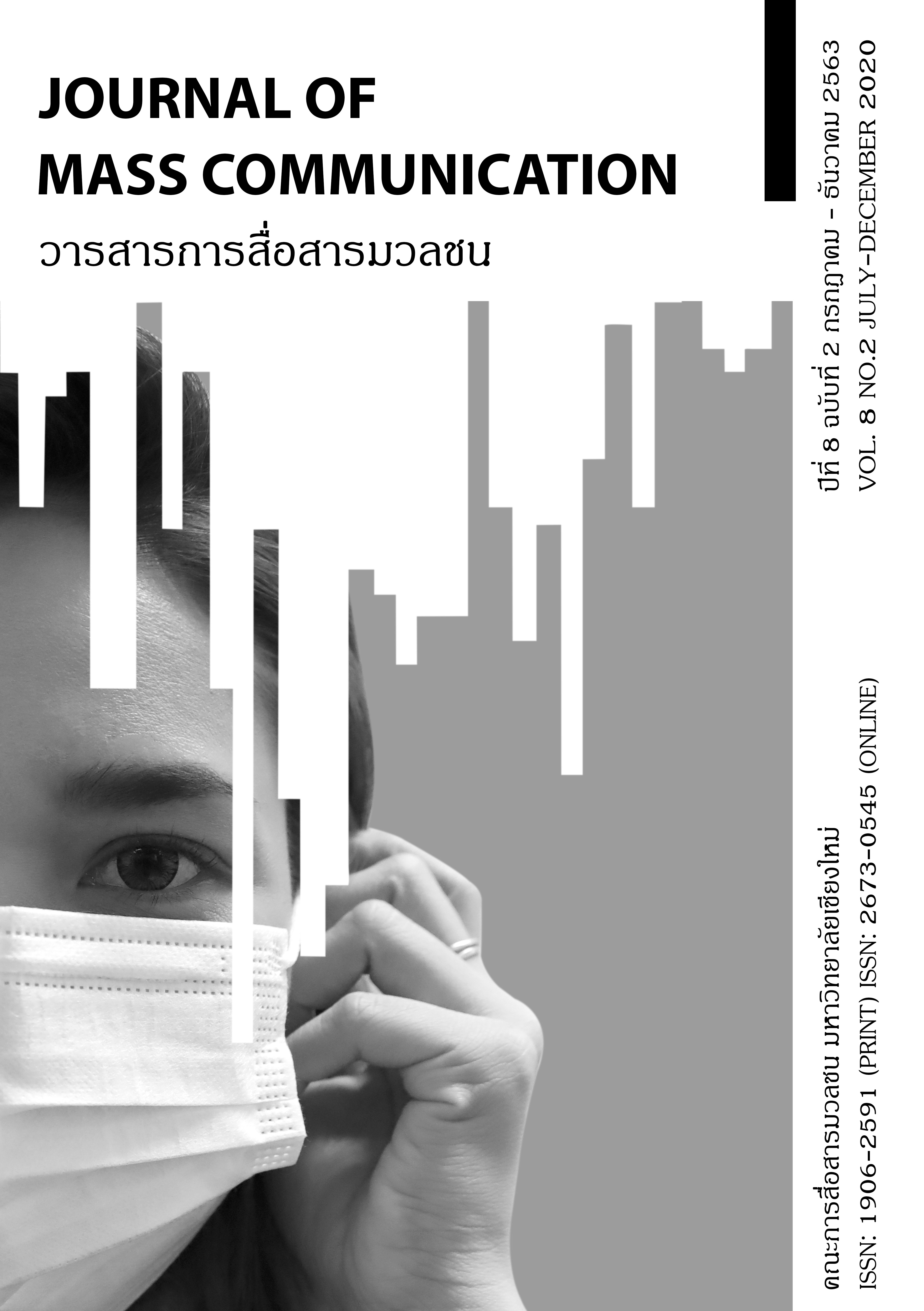ทฤษฎีวงเกลียวแห่งความเงียบในการเลือกตั้งทั่วไปของไทย ปี 2562
Main Article Content
บทคัดย่อ
การศึกษาครั้งนี้มีวัตถุประสงค์หลักเพื่อศึกษาอิทธิพลร่วมของตัวแปรการเปิดรับสื่อออนไลน์และความกลัวการเผชิญหน้ากับความขัดแย้ง กับความเต็มใจที่จะเลือกพรรคการเมือง ในช่วงระยะเวลา 2 สัปดาห์สุดท้ายก่อนมีการเลือกตั้งของไทย ปี 2562
ผู้วิจัยได้ใช้วิธีการสุ่มแบบอาสาสมัคร โดยส่งแบบสอบถามไปทางออนไลน์ จำนวน 319 ชุด จากนั้นวิเคราะห์ข้อมูลด้วยสถิติเชิงพรรณนา (descriptive statistics) และสถิติเชิงอนุมาน (inferential statistics) เพื่อทดสอบสมมติฐานประกอบด้วย การวิเคราะห์ค่าสหสัมพันธ์เพียร์สัน และการวิเคราะห์ความแปรปรวนร่วม
ผลการศึกษา พบว่า ตัวแปรด้านการเปิดรับสื่อกับตัวแปรทางด้านจิตวิทยามีความสัมพันธ์กับความเต็มใจที่จะลงคะแนนเสียงเลือกพรรคการเมืองที่ตั้งใจไว้ ยกเว้นตัวแปรความไม่สอดคล้องกับบรรยากาศความคิดเห็นของคนส่วนใหญ่ และจากการทดสอบปฏิสัมพันธ์ร่วมกับตัวแปรต่างๆ ตามทฤษฎีวงเกลียวแห่งความเงียบ พบว่า ความถี่การเปิดรับสื่อออนไลน์และความกลัวการเผชิญหน้ากับความขัดแย้ง มีปฏิสัมพันธ์ร่วมต่อความเต็มใจที่จะลงคะแนนเสียงให้พรรคการเมือง และตัวแปรความไม่สอดคล้องฯ และตัวแปรความกลัวการเผชิญหน้ากับความขัดแย้ง มีปฏิสัมพันธ์ร่วมต่อความเต็มใจที่จะลงคะแนนเสียงให้พรรคการเมืองอย่างมีนัยสำคัญทางสถิติ ขณะที่ตัวแปรความกลัวการโดดเดี่ยวไม่พบปฏิสัมพันธ์ร่วมกับตัวแปรอื่นๆ
Article Details
ลิขสิทธ์ที่ผู้เขียนบทความต้องยอมรับ
เอกสารอ้างอิง
วัฒนธรรมไทย. วารสารนิเทศศาสตร์, 26(2), 1-19.
สุจิตรา สามัคคีธรรม.(2553). วัฒนธรรมกับการจัดการความขัดแย้ง: การศึกษาเปรียบเทียบระหว่างประเทศ. วารสาร
การเมือง การบริหาร และกฎหมาย, 2 (2), พฤษภาคม- สิงหาคม, 35-71.
Glynn, Carroll J. , Andrew F.Hayes and James Shanahan. (1997). Percieved support for one’s
opinions and willingness to speak out: a meta-analysis of survey studies on the spiral of
silence. Public Opinion Quarterly, 61 (3), 452-463.
Huiping Huang.(2005). A cross cultural test of the spiral of silence. International Journal of
Public Opinion Research, 17 (3), 324-345.
Ito, Youichi. (1993). The future of political communication research : a Japanese perspective.
Journal of Communication, 43 (4), 69-79.
Jeffres, Leo W. (1997). Mass media effects. Prospect Heights, Illinois : Waveland Press.
Na Teon Lee and Yonghwan Kim. (2014). The spiral of silence and journalists’ outspokenness on Twitter.
Asian Journal of Communication, 24(3), 262-278.
Neuwirth, Kurt, Edward Frederick and Charles Mayo. (2007). The Spiral of Silence and Fear of Isolation.
Journal of Communication, 57 (3), 450-468.
Noelle-Neumann,Elisabeth.(1991).The theory of public opinion: the concept of the spiral of
silence. In J.A. Anderson (ed.), Communication Yearbook, pp.260. CA: Sage.
Noelle-Neumann, Elisabeth and Thomas Petersen.(2004). The spiral of silence and the social
nature of man. In Lynda Lee Kaid (ed.). Handbook of political communication
research. pp.347-348. USA: Lawrence Erlbaum Associates.
Praszkier,Ryszard and Bartoli,Andrea.(2014).The Role of Society in the Peace Process of the Basque
Country. International Journal of Peace Studies, 19 (2) Winter, 69-93.
Salmon,Charles T. and Chi-Yung Moh. (1994). The spiral of silence: linking individual and
society through communication. In J. David Kennamer (ed.), Public Opinon the press
and public Policy, p.147. Westport, Connecticut: Praeger.
Scheufele, Dietram A. and Patricia Moy. (2000). Twenty-five years of the spiral of silence: a
conceptual review and empirical outlook. International Journal of Public Opinion
Research 12 (1), 3-28.
Sei-Hill Kim, Hwalbin Kim and Sang-Hwa Oh. (2014).Talking About Genetically Modified (GM) Foods in
South Korea: The Role of the Internet in the Spiral of Silence Process. Mass Communication and Society, 17 (5), 713-732.
Sei-Hill Kim, Miejeong Han, James Shanahan and Vicente Berdayes. (2004). Talking on sunshine
in north Korea : A test of the spiral of silence as a theory of powerful mass media.
International. Journal of Public Opinion Research, 16 (1), 39-62.
Yang Xiaodong, Li Li,. (2016). Will the spiral of silence spin social networking sites? An experiment on
public opinion climate, fear of isolation and outspokenness. China Media Research, 12 (1), 79-87.
Y Tsfati, NJ Stroud, and A Chotiner.(2014). Exposure to ideological news and perceived opinion climate:
Testing the media effects component of spiral-of-silence in a fragmented media landscape.
The International Journal of Press/Politics, 19 (1), 3-23.


